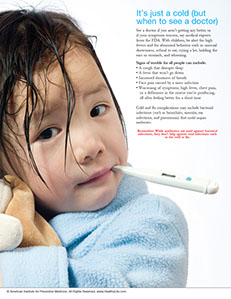SYMPTOM CHECKER
CONDITIONS
Male
Female
Child
Arm, Hand & Shoulder Concerns
Legs & Feet Concerns
Dental & Mouth Concerns
Ear & Nose
Eye Conditions
Head Conditions
Arm, Hand & Shoulder Concerns
Legs & Feet Concerns
Front
Back
Arm, Hand & Shoulder Concerns
Dental & Mouth Concerns
Ear & Nose
Eye Conditions
Head Conditions
Arm, Hand & Shoulder Concerns
Dental & Mouth Concerns
Ear & Nose
Eye Conditions
Head Conditions
Front
Back
Arm, Hand & Shoulder Concerns
Neck Links
Head & Neck Concerns
Arm, Hand & Shoulder Concerns
Neck Links
Head & Neck Concerns
Front
Back
Online Clinic
Wise Healthcare
It’s just a cold (but when to see a doctor)
Print on Demand
See a doctor if you aren’t getting any better or if your symptoms worsen, say medical experts from the FDA. With children, be alert for high fevers and for abnormal behavior such as unusual drowsiness, refusal to eat, crying a lot, holding the ears or stomach, and wheezing.
Signs of trouble for all people can include:
• A cough that disrupts sleep
• A fever that won’t go down
• Increased shortness of breath
• Face pain caused by a sinus infection
• Worsening of symptoms, high fever, chest pain, or a difference in the mucus you’re producing, all after feeling better for a short time
Cold and flu complications may include bacterial infections (such as bronchitis, sinusitis, ear infections, and pneumonia) that could require antibiotics.
Remember: While antibiotics are used against bacterial infections, they don’t help against viral infections such as the cold or flu.
This website is not meant to substitute for expert medical advice or treatment. Follow your doctor’s or health care provider’s advice if it differs from what is given in this guide.
The American Institute for Preventive Medicine (AIPM) is not responsible for the availability or content of external sites, nor does AIPM endorse them. Also, it is the responsibility of the user to examine the copyright and licensing restrictions of external pages and to secure all necessary permission.
The content on this website is proprietary. You may not modify, copy, reproduce, republish, upload, post, transmit, or distribute, in any manner, the material on the website without the written permission of AIPM.
2021 © American Institute for Preventive Medicine - All Rights Reserved. Disclaimer | www.HealthyLife.com















































_web-u573076-fr.jpg?crc=4106038948)

